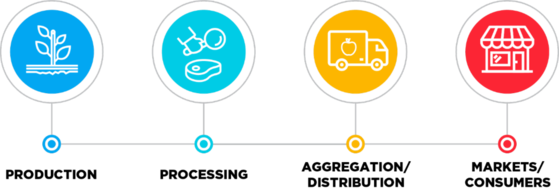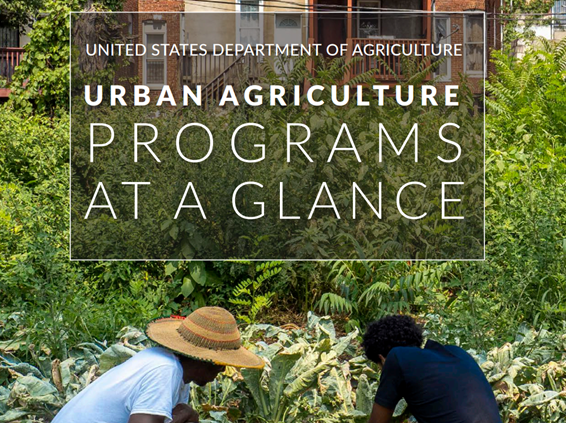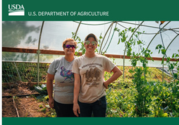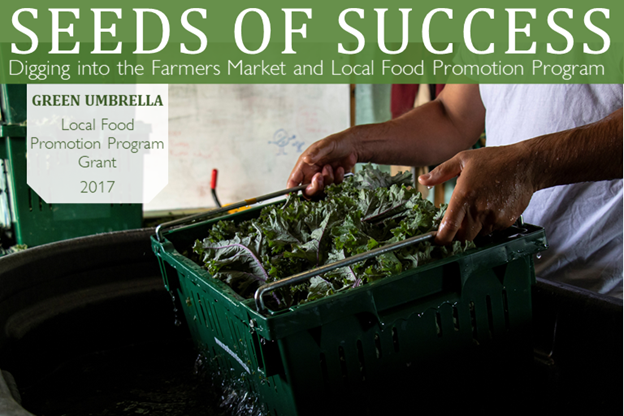On June 1, Agriculture Secretary Tom Vilsack announced details of a framework to transform the food system to benefit consumers, producers and rural communities by providing more options, increasing access, and creating new, more, and better markets for small and mid-size producers. The goals of USDA’s Food System Transformation framework include:
- Building a more resilient food supply chain that provides more and better market options for consumers and producers while reducing carbon pollution;
- Creating a fairer food system that combats market dominance and helps producers and consumers gain more power in the marketplace by creating new, more and better local market options;
- Making nutritious food more accessible and affordable for consumers; and
- Emphasizing equity.
The investments and programs Secretary Vilsack announced last week fit into four buckets of work that span the supply chain from production to markets. AMS will have a prominent role focusing on the middle of the supply chain.

New or expanding AMS programs include:
- Creation of a robust technical assistance network to ensure that participants in USDA’s meat and poultry supply chain initiatives have access to a full range of technical assistance to support their project development and success. Meat and poultry processing facilities are complex, with many technical standards and requirements; the odds of successfully starting or expanding a facility are higher with access to expertise and experience. USDA is deploying $25 million through the Meat and Poultry Processing Capacity Technical Assistance Program.
- Investment of $400 million to create regional food business centers that will provide coordination, technical assistance, and capacity building support to small and mid-size food and farm businesses, particularly focused on processing, distribution and aggregation, and market access challenges. The business development needs of food businesses are distinct from other small businesses and existing business support networks such as those the Small Business Administration provides are insufficient to developing robust local and regional markets where food businesses flourish. The Centers will be designed to support to underserved communities in a particular region as identified by the applicant.
- Investing $60 million to leverage increased commodity purchases through Farm-to-School. Farm-to-school programs are a proven model of increasing markets for farmers via child nutrition programs while also providing children healthy, fresh food. These grants to states and territories administering farm to school programs will support increased procurement and use of local foods in child nutrition program meals.
Recent Opportunities
Funding for state agencies and Non-Profits
GusNIP Nutrition Incentive Program
Application Due Date: June 30, 2022
The GusNIP Nutrition Incentive Program presents the opportunity to bring together stakeholders from various parts of the food and healthcare systems to foster understanding of how they might improve the health and nutrition status of participating households.
GusNIP Produce Prescription Program
Application Due Date: June 30, 2022
The primary goal and objective of the GusNIP Produce Prescription Program is to demonstrate and evaluate the impact of projects on (1) the improvement of dietary health through increased consumption of fruits and vegetables; (2) the reduction of individual and household food insecurity; and (3) the reduction in healthcare use and associated costs.
Funding for a variety of eligible entities
NIFA Agriculture and Food Research Initiative (AFRI) Sustainable
Agricultural Systems
Application Due Date: July 28, 2022
The USDA’s National Institute of Food and Agriculture’s (NIFA) Agriculture and Food Research Initiative (AFRI) Sustainable Agricultural Systems supports approaches that promote transformational changes in the U.S. food and agriculture system. NIFA seeks creative and visionary applications that take a systems approach for projects that are expected to significantly improve the supply of affordable, safe, nutritious, and accessible agricultural products while fostering economic development and rural prosperity in America. Learn more.
Funding for qualified lenders
Food Supply Chain Guaranteed Loan Program
Application Due Date: Applications accepted until funds are exhausted
The USDA Rural Development Food Supply Chain Guaranteed Loan Program authorized by the American Rescue Plan. This program guarantees loans of up to $40 million for qualified lenders to finance food systems projects, specifically for the start-up or expansion of activities in the middle of the food supply chain. The program will support new investments in infrastructure for food aggregation, processing, manufacturing, storage, transportation, wholesaling, and distribution. Learn more.
Local and Regional Food Systems Response and Recovery Webinar Series
Please take a moment to complete this short survey to help the project team take steps to maintain the network of interested partners who want to stay connected on issues after the webinar series.
Mark your calendar for the COVID Recovery and Resilience fall webinar series, which will kick off on Friday, September 9 from 12:00 – 1:30 pm ET. The webinar will start with a brief presentation from the Data and Metrics Action Team about their innovative new tool to improve access to data collection, analysis, and utilization to foster a more equitable and resilient food system. The webinar will then shift gears, and small groups of participants will be asked to give feedback on the tool.
In the meantime, check out the recordings and summaries of past webinars!
Urban Agriculture Toolkit

The USDA recently released an urban agriculture toolkit, which provides resources for both producers and farm system partners. Tools include grants, loans, partnering with farmers markets and programs like WIC, crop insurance, and many other USDA services that can help urban farmers feed their communities.
Fridays on the Farm: Creating a Happy Homestead in Kentucky
 Our colleagues in USDA’s Farm Production and Conservation (FPAC) publish a series showing how producers have used FPAC resources to grow their farms. Recently, Fridays on the Farm featured Andee and Lindsey Stevens of Happy Hens Homestead in Booneville, Kentucky. The couple wanted to create a simple, healthy, and sustainable lifestyle for their family, and a great environment to raise their kids in. With support from several Natural Resources and Conservation Service programs, they transformed what was once a tobacco and cattle farm with major soil health concerns into a successful diversified farm selling direct to consumer online, at farmers markets, to local restaurants, and through community supported agriculture programs. Our colleagues in USDA’s Farm Production and Conservation (FPAC) publish a series showing how producers have used FPAC resources to grow their farms. Recently, Fridays on the Farm featured Andee and Lindsey Stevens of Happy Hens Homestead in Booneville, Kentucky. The couple wanted to create a simple, healthy, and sustainable lifestyle for their family, and a great environment to raise their kids in. With support from several Natural Resources and Conservation Service programs, they transformed what was once a tobacco and cattle farm with major soil health concerns into a successful diversified farm selling direct to consumer online, at farmers markets, to local restaurants, and through community supported agriculture programs.
|
Seeds of Success: Digging into Farmers Market and Local Food Promotion Program
Each month, we’re highlighting the work of Farmers Market and Local Food Promotion grant recipients.
Green Umbrella

Green Umbrella, a non-profit in Cincinnati, Ohio, was originally formed in 1998 to address diminishing natural areas and biodiversity in the Ohio-Kentucky-Indiana region. With support from a 2017 Local Food Promotion Program (LFPP) grant, Green Umbrella worked with two regional food hubs, Ohio Valley Food Connection (aka Local Food Connection) and Our Harvest Cooperative. The resulting Ohio Valley Local Food Hub Project significantly improved food distribution in the region, impacting producers, distributors, institutional, wholesale and household buyers, and others affiliated with the distribution network.